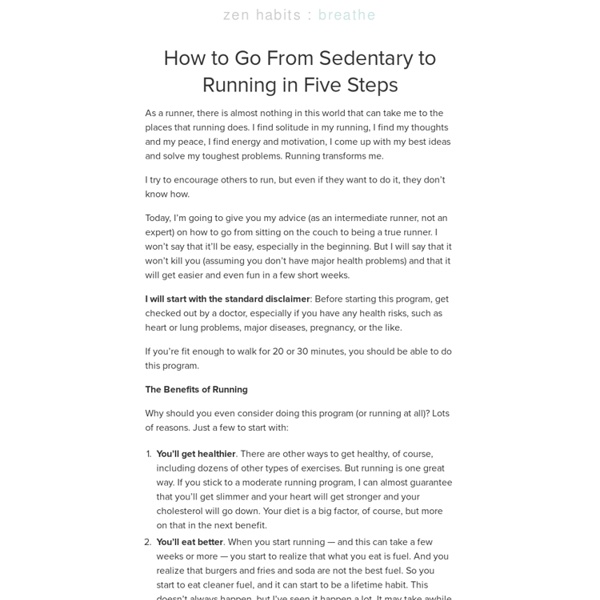How to Go From Sedentary to Running in Five Steps

Instant Ab Flatteners on Yahoo! Health
Achieving a toned, sexy tummy might seem like a pipe dream this time of year. Baggy sweaters abound, egg nog is served and Frosty the Snowman doesn't offer much in the way of flat-belly inspiration. But getting a sleek, sexy stomach is easier than you think. We rounded up five of the most effective tummy toners around. Pike 90Lie faceup; raise legs until perpendicular to floor, feet flexed. Crunchy frogSit with knees bent, feet flat. TornadoStand with feet hip-width apart, right leg in front of left, right foot turned out. CorkscrewLie faceup. Side arm balanceStart on floor on knees.
What You Should & Shouldn't Buy Organic
Organic food may be the better and safer choice when it comes to feeding your family, however it can also be costly and cause heavy damage on your wallet. Follow these guides on what you should and shouldn't buy organic. Things You can Buy Safely (Non-organic) Fruit Avocado Their thick skins that protect the fruit from pesticide build-up. How to Buy it: You want an avocado that is slightly unripe and is firm tot he squeeze, they will ripen in a few days of sitting on your kitchen counter. Bananas The banana peel isn't eaten and its where the pesticide stays. How to Buy it: You'll want to think of how you are going to use the banana before you choose it. Pineapple It has a rough and spiny skin that protects it from pests and pesticide residue. How to Buy it : Although the sweet smell of pineapple can be alluring, you don't want to use your nose on this one because it usually means that it is overripe. Kiwi How to Buy it: When buying kiwi, you have to use your nose. Mango Papaya Vegetable Asparagus
Sports Coach provides information on training, coaching, exercise physiology and athletic development for sports coaches, athletes and sports science students
Treat Beach Wounds
From Wired How-To Wiki Illustration: Jason Lee/Wired There are plenty of lurking dangers under the beautiful waves of the beach. The thin line between an idyllic day at the beach and one filled with tears is an unbalanced step or swim stroke in the wrong direction. You don't have to come to the beach packed to the gills with emergency equipment. Here are some just in case a sea creature decides to get a little too close on your next family vacation. This article is a wiki. Jellyfish The acetic acid in vinegar can ease the pain of a jellyfish sting. It also works on sea anemone larvae, microscopic buggers that leave you covered in tiny red bumps. A quicker remedy is meat tenderizer. Do not use vinegar for Portuguese man-of-war stings. Sea Urchin Urchin spine stuck in your foot? If it's deep enough to remove, pull the urchin spine out. Apply heat. Stingray Stingray poison is neutralized by ammonia. Coral The extent and reaction depend on the type of coral and the exposure to it. Sunburn Hot Coals
15 Tips to Restart the Exercise Habit (and How to Keep It) - lifehack.org
It’s okay, you can finally admit it. It’s been two months since you’ve seen the inside of the gym. Getting sick, family crisis, overtime at work and school papers that needed to get finished all kept you for exercising. Now, the question is: how do you start again? Once you have an exercise habit, it becomes automatic. Don’t Break the Habit – The easiest way to keep things going is simply not to stop.
Cheap, safe drug kills most cancers - health - 17 January 2007
New Scientist has received an unprecedented amount of interest in this story from readers. If you would like up-to-date information on any plans for clinical trials of DCA in patients with cancer, or would like to donate towards a fund for such trials, please visit the site set up by the University of Alberta and the Alberta Cancer Board. We will also follow events closely and will report any progress as it happens. Update, 16 May 2011: If you've just heard about this story, please read this recent update too. Article originally published online 17 January 2007: It sounds almost too good to be true: a cheap and simple drug that kills almost all cancers by switching off their "immortality". It also has no patent, meaning it could be manufactured for a fraction of the cost of newly developed drugs. DCA attacks a unique feature of cancer cells: the fact that they make their energy throughout the main body of the cell, rather than in distinct organelles called mitochondria. More from the web
Related:
Related:



